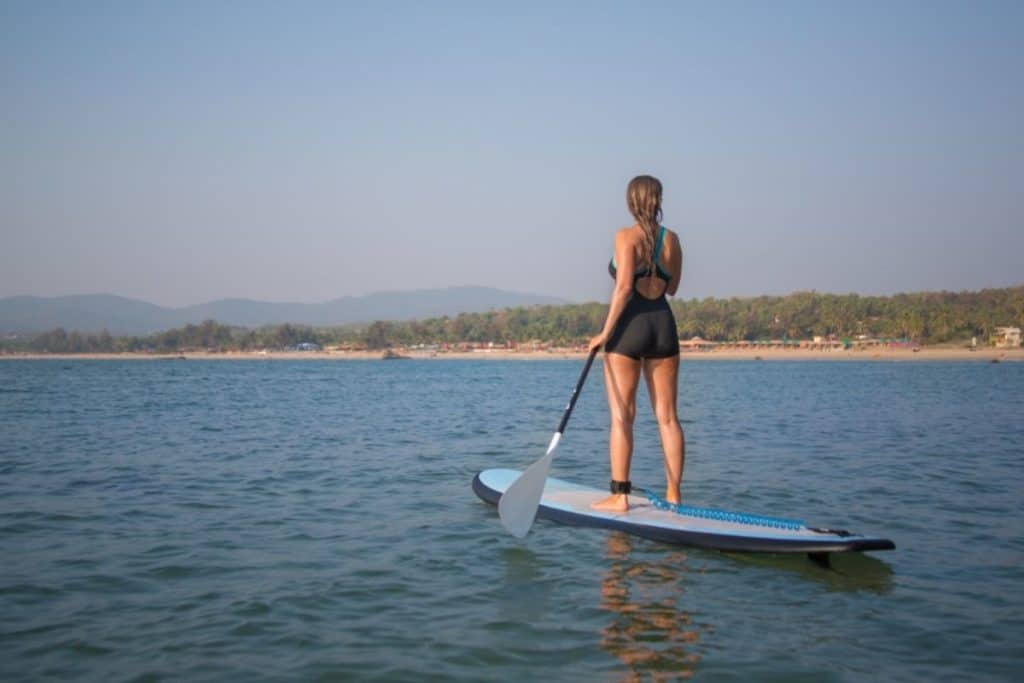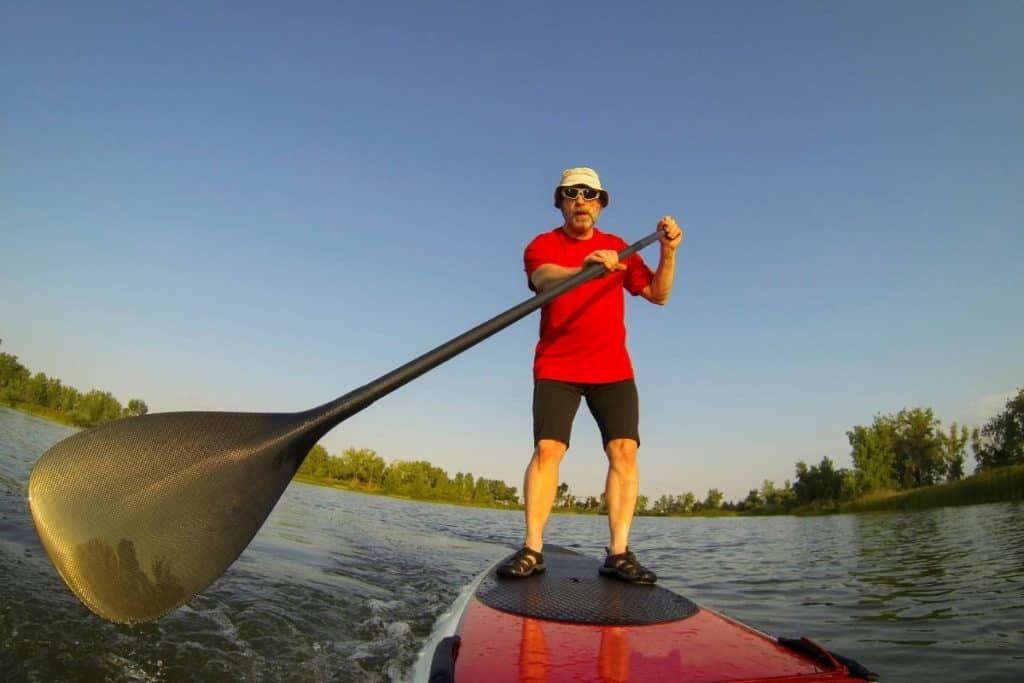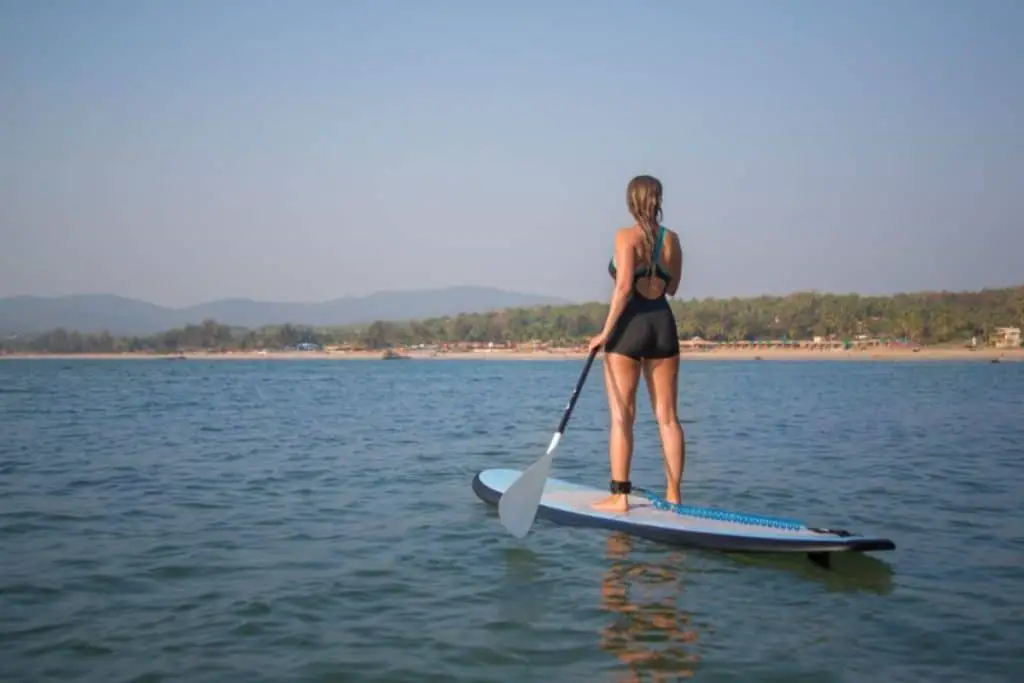As an Amazon Associate we earn from qualifying purchases.
Paddle boarding is a really fun sport and a great way to get out onto the water and enjoy the outdoors. It works your muscles as you need to be able remain balanced, but it is also relaxing once you get the hang of it.

When you have your paddle board and all of your accessories ready, and you have chosen a place with nice calm waters, you are ready to have a go! But how do you do it? How do you stand up on your paddle board?
We have put together this useful guide which takes you through all of the steps you need to follow in order to stand up on your Stand Up Paddle Board.
Table of Contents
Step One – Adjust The Paddle
One of the items you need to get started is your paddle. They are usually made from aluminum and are adjustable in length.
If you are using the paddle without adjusting it to your height then you could be making it much harder for yourself. Place the oar of the paddle on the floor and hold the paddle upright with one hand in the air.
The top of the paddle should be in line with your wrist. Once you have adjusted the length of the paddle be sure to secure it properly.
Step Two – Get The Board In The Water
If you have an inflatable paddle board you will need to get it ready, or if you have a solid paddle board you can get started as soon as you arrive at your destination. Most paddle boards have carry handles which makes it easier to get them in and out of the water.
You should be able to carry it under your arm just like a surfboard. If it is a windy day then make sure you carry the paddle board with the smallest surface area (the point of the nose) facing into the wind.
If there is quite a long walk to the water’s edge then you can carry the paddle board on your head so that the weight is more evenly distributed.
When you reach the water, place the paddle board on the floor with the nose pointing into the water. Attach your ankle leash, raise the tail, and then push the board out into the water. Keep going until the board is no longer touching the floor and is fully afloat.
Step Three – Begin Paddling On Your Knees
Stabilize the board and stand so it is perpendicular to your body, then climb onto it so that you are in a kneeling position. From this position, you should be able to get a feel for the board and the water.
Start by just trying to keep your balance on the board, then when you are comfortable, you can begin paddling in this kneeling position.
Make sure your toes are tucked under your feet and gripping the board. Reach your paddle out in front of you and lift it up and out of the water when it is level with your knees, then repeat. It will be easier to remain balanced in a kneeling position, so this is good practice to help you get used to paddle boarding.

Step Four – Stand Up
When you are ready to try standing up on your paddle board, place the paddle down so that it is lying perpendicular to the board.
Place both hands out in front of you over the paddle and lift up your bottom as if you are getting ready to ‘bear crawl’ (this is why the toes need to be tucked underneath the feet so they can grip the board).
With your hands still on the board to support your weight, carefully bring each knee to your chest so you are in a squatting position.
Try to keep your feet flat and take your body weight through the balls of your feet. Make sure your feet are shoulder width apart, then push yourself up from squatting to standing, picking up your paddle and taking it with you.
Keep your back straight and your feet flat to ensure that the paddle board remains steady.
Step Five – Adjust Your Position
Once you are standing on the board, you will need to make sure you are positioned correctly to ensure that you remain balanced.
If you are too far forward then the nose of the board will be dipping into the water, and if you are too far back then it will be sticking out of the water. Either way, as soon as you begin paddling the board will tip.
Plant your paddle on your board in front of you, tip down, to help you keep your balance. Shift your weight forwards or backwards one small bit at a time.
Make sure that neither the nose nor the tail of the paddle board are sticking out of the water. Once you find your ideal position try to take a note of it so you remember for next time.
Step Six – Begin Paddling In A Standing Position
Now that you are stood up and your position on the board is correct, it is time to start paddling. Keep your knees in a soft bend to support your weight and make sure your feet remain flat as this will help you to keep your balance and give you a better grip on the board.
Place your paddle into the water- you will want to reach far enough that you get a good stroke and make progress but not so far that you lose your balance. Bend your body, leaning slightly forward to complete the stroke.
The arm that is on the top of the paddle pushes it into the water whereas the arm that is lower down on the paddle pulls it through the water towards you.
When the paddle is in line with your feet, bring it out of the water and repeat. Switch sides every three to four strokes to even out the strain on your arms and body and to keep your direction straight. Every movement needs to be controlled, and your core will need to be engaged at all times to keep you balanced.
Amazon and the Amazon logo are trademarks of Amazon.com, Inc, or its affiliates.

